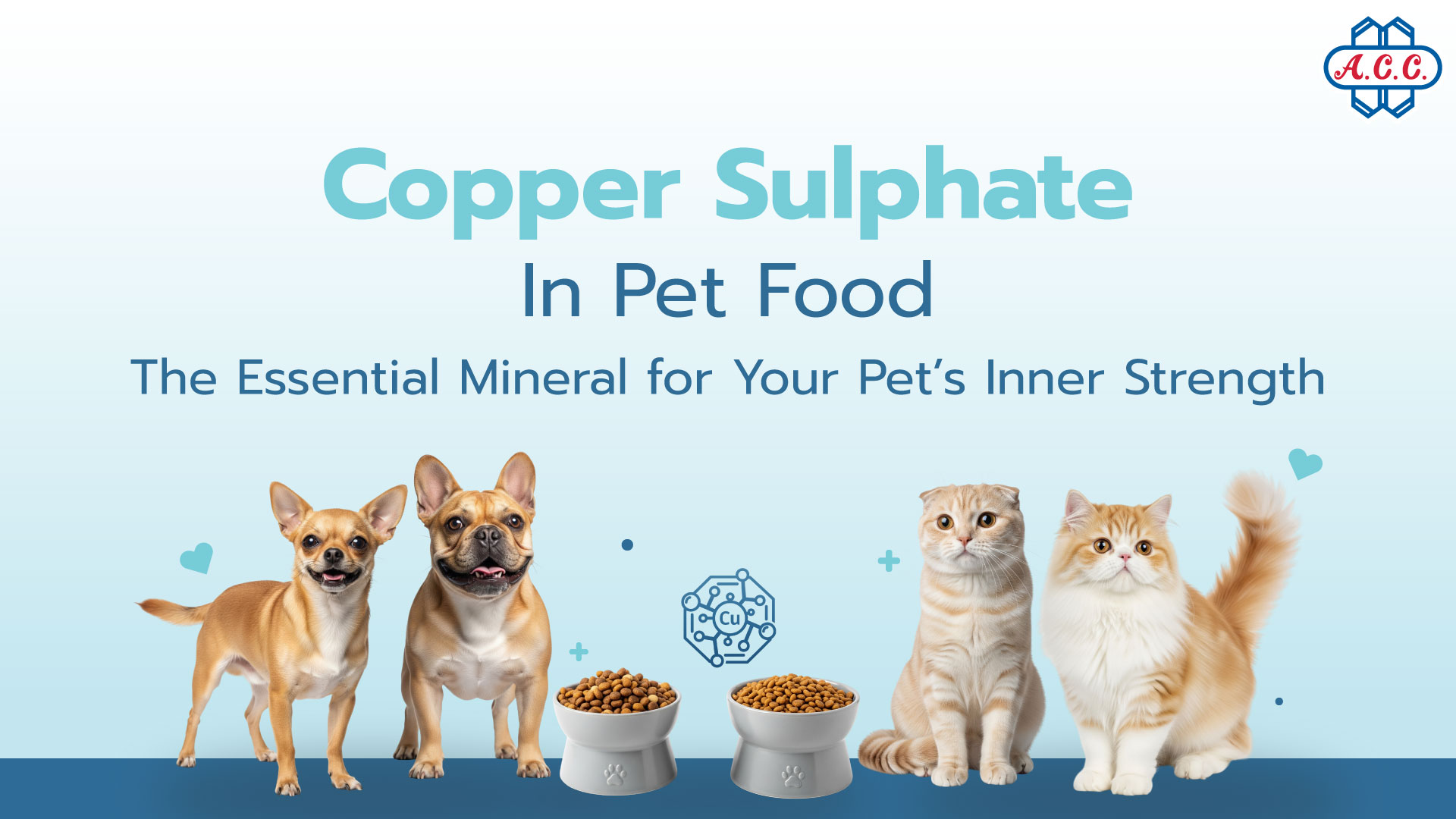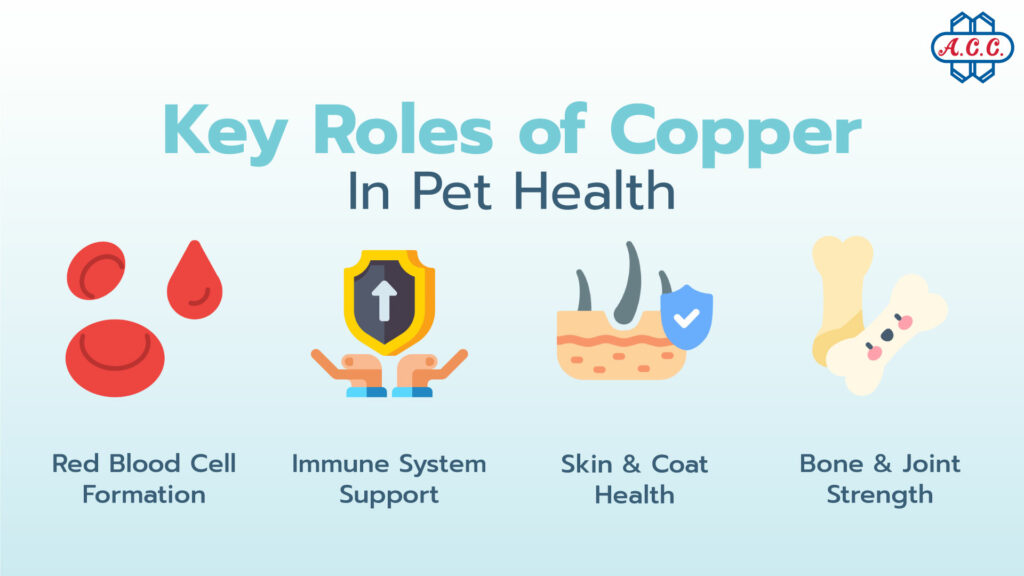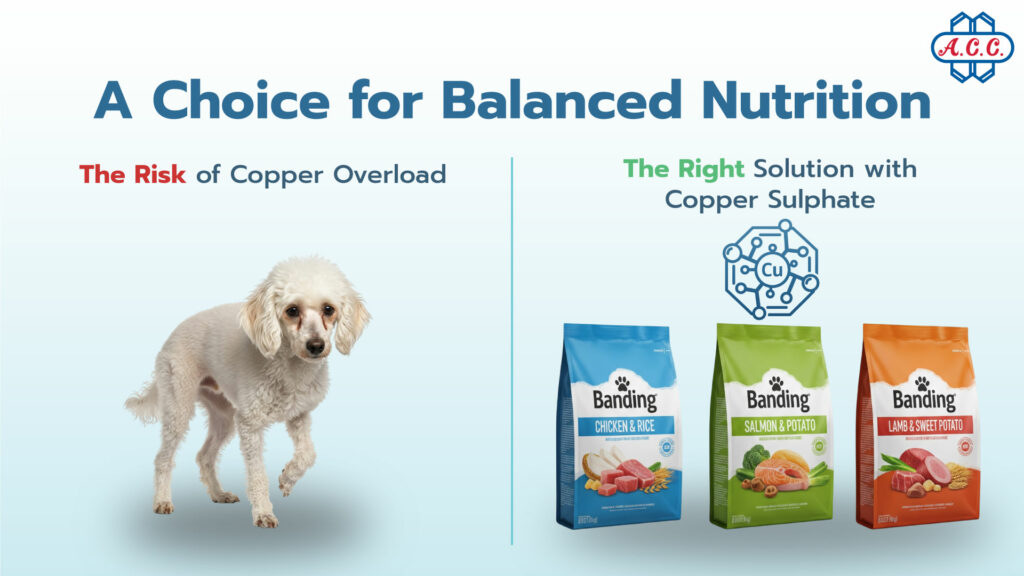
18 Aug “Copper in Pet Food” The Essential Mineral That Makes Dogs and Cats Strong from Within
In today’s world, an increasing number of people are choosing to raise pets instead of having children. They care for them devotedly because they want their four-legged friends to be healthy, vibrant, and happy every day. And one of the most fundamental factors is “food.” But have you, as a pet owner, ever wondered if the high-quality kibble you’ve carefully selected might not be enough for your pet? This is especially true when it comes to an essential mineral like “copper,” as the needs for this mineral can vary between each dog and cat, their age, and their breed.
In this article, we invite you to understand why copper is incredibly important for pets. And most importantly, we will delve into the breed-specific risks that you, as an owner, should be aware of. This will help you select food with the most appropriate level of copper (copper sulphate) from a trustworthy source for your pet.
Why is “Copper” Important for Dog and Cat Health?
Before we get into breed-specific needs, let’s first understand that copper is a “trace mineral” that plays a vital role in the body of a pet in many ways. The primary functions of copper in an animal’s body are so numerous they might surprise you.
∘ Red Blood Cell Formation Copper is a crucial component in the process of creating red blood cells. It enables the body to efficiently transport oxygen and helps prevent anemia.
∘ Immune System Support Copper assists in the function of enzymes and immune cells, making a pet’s immune system strong and capable of fighting off various pathogens.
∘ Coat and Skin Health Copper is essential for the production of melanin, which gives a pet’s coat its natural, beautiful color. A copper deficiency can lead to a dull, faded coat that is in poor condition and sheds easily.
∘ Bone and Joint Support Copper helps in the formation of collagen and connective tissues, making bones, joints, and tendons strong.
∘ Nervous System Function Copper plays a role in maintaining the integrity of the myelin sheath, which is necessary for the proper transmission of nerve signals.
Therefore, receiving an appropriate amount of copper continuously from food is extremely important. And one of the most popular and highly effective sources of copper in the pet food industry is copper sulphate.

Unequal Copper Needs Making Breed Differences Important
In the field of pet nutrition, while there are standard recommended amounts of copper, these values are just averages for general pets. In reality, each animal, especially each dog and cat breed, may have genetic factors that cause a significant difference in how their body absorbs or manages copper.
For example, some dog breeds may have a system for excreting excess copper that does not work well. This can lead to a buildup of copper in the liver, causing problems. This makes it especially important to be cautious when selecting food for dogs in high-risk groups. This fact reinforces that “not just any food will do,” and understanding the copper needs of each pet breed is key.
Breed-Specific Risks When Copper Can Be Both a Friend and an Enemy
When it comes to copper in pets, we must be careful of both “deficiency” and “excess,” as these problems are often directly linked to a specific breed.
-
Copper Storage Disease
This is the most concerning problem and usually occurs in certain dog breeds with a genetic abnormality that prevents them from excreting excess copper normally. This results in copper accumulating in the liver, causing damage and eventually leading to liver failure.
∘ High-Risk Dog Breeds
∘ Bedlington Terrier is a breed known for its high genetic risk for this condition.
∘ Labrador Retriever, especially certain family lines, have been found to be at high risk.
∘ Doberman Pinscher, West Highland White Terrier, Skye Terrier, and other breeds.
Observable Signs There may be no symptoms at first, but as copper accumulates and liver damage begins, a pet may show signs of loss of appetite, lethargy, vomiting, diarrhea, and jaundice, which indicates a serious liver problem.
-
Copper Deficiency
In general, this condition is not common in pets that receive high-quality standard kibble. However, it can occur if a pet is fed a homemade diet or in some animals that have a problem absorbing copper. Food that contains a proper amount of copper sulphate can help prevent this problem effectively.
From the information above, we can see that choosing food with an appropriate amount of copper, not too much or too little, is extremely important, especially for pets with breed-specific risks. Screening and choosing pet food manufacturers that use a quality copper source like copper sulphate helps ensure that our pets receive the correct nutrition.

The Role of “Copper Sulphate” in Creating Balanced Nutrition
Why do pet food manufacturers choose copper sulphate as a source of copper? The reason is that copper sulphate is a compound with high purity and is easily accessible. This has made it a popular choice for the animal feed industry for a long time.
The outstanding property of copper sulphate is that it is a highly concentrated source of copper. It can be mixed into animal feed in precise amounts according to the nutritional formula. And most importantly, it is a source of copper that an animal’s body can absorb and utilize efficiently (Bioavailable), ensuring your pet receives the required amount of copper.
Precise Quantity Control Using copper sulphate allows manufacturers to control the amount of copper in food with great accuracy to meet the nutritional standards set by various institutions like AAFCO. This is extremely important in producing food for animals at risk of copper storage disease. The correct use of copper sulphate helps create balance in pet food effectively.
Tips for Owners: How to Choose Food to Meet the Health Needs of Each Pet Breed
Consult a veterinarian first. If you own a dog breed at risk for copper storage disease, it is essential to consult a veterinarian for advice on an appropriate diet. This ensures you receive accurate guidance on the amount of copper your pet should receive daily.
Learn to read the food label. Look for “Guaranteed Analysis” or the nutritional analysis on the food bag, especially the amount of Copper, to see if it is at an appropriate level. Also, consider the ingredients to see if a reliable source of copper is used, as copper sulphate is one of the most widely used.
Choose a reliable brand. Buy food from manufacturers that meet standards, have quality control, and list their ingredients clearly. This ensures that the food your pet receives is complete and balanced, with the correct amount of copper for your pet’s needs.
Conclusion
Copper is not just an ordinary trace mineral; it is a vital component behind the creation of strong health for our pets. And making an informed choice about food that is rich in a quality copper source like copper sulphate at the appropriate level is a crucial step to give our pets a good life and happiness every day.
Asian Chemical Company Limited (ACC) is a leader in the production and distribution of industrial chemicals in Thailand. We are well aware of the importance of high-quality minerals for health and productivity in the livestock industry. We are committed to producing high-quality Copper Sulphate, which is part of our mineral feed group, that undergoes strict quality control at every step. This ensures that you can be confident that your pet receives a safe and highly effective source of copper to promote health and growth.
Our copper sulphate product not only meets the nutritional needs of animals but is also certified by numerous world-class international standards, including ISO9001, ISO14001, ISO45001, ISO/IEC 17025, FAMI QS, HACCP, and GMP. This is a testament to our commitment to delivering the best products and services to leading customers both domestically and internationally, with a sustainable social and environmental responsibility.
📞 Tel: +66 (38) 570 150-2 ext. 106, 107 or +66 (81) 8337 043
📩 E-mail: [email protected]
🌐 Website: https://acc1976.com/th/
🏢 Asian Chemical Company Limited
85/1 Moo 5, Wellgrow Industrial Estate, Bangna-Trad Rd. Km.36, Bang Samak Sub-district, Bang Pakong District, Chachoengsao 24130



No Comments